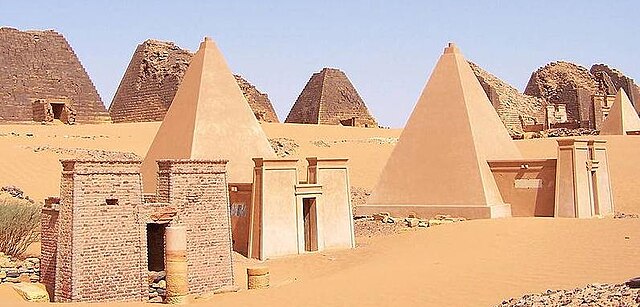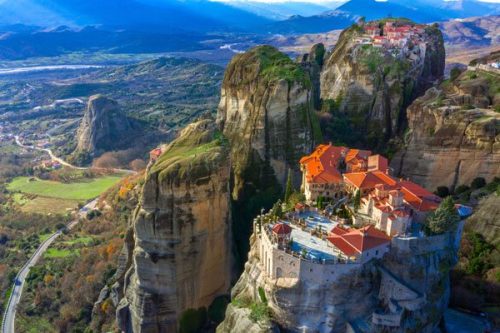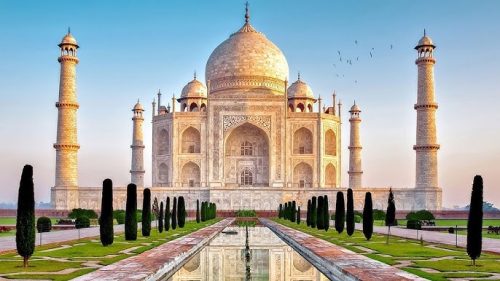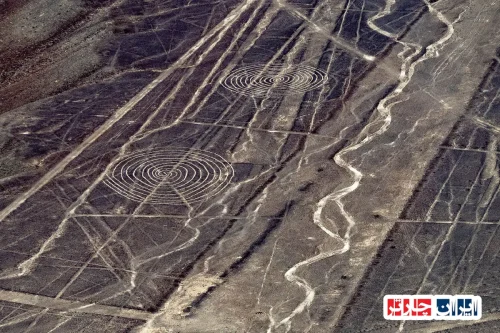Discover the Magnificent Pyramids of Meroë in Sudan: An Unforgettable Journey into Ancient African Heritage
Embark on a captivating exploration of the Pyramids of Meroë-Iran Charter and delve into the rich history, architectural marvels, and cultural significance of these ancient structures. Located in the heart of Sudan, the Pyramids of Meroë Meroë Sudan stand as a testament to the ingenuity and spiritual beliefs of the ancient Kushite civilization. These pyramids, with their unique design and historical importance, attract scholars, tourists, and history enthusiasts from around the world, offering a glimpse into a civilization that thrived thousands of years ago. Discover how these iconic monuments symbolize power, religious devotion, and artistic excellence, making them an essential part of Africa’s archaeological heritage. Whether you are interested in ancient architecture, cultural history, or archaeological discoveries, the Pyramids of Meroë in Sudan provide an extraordinary experience that bridges the past and present, revealing secrets of a bygone era and inspiring future generations to preserve this invaluable legacy.

Discover the Rich History and Architectural Marvels of the Pyramids of Meroë in Sudan
The Pyramids of Meroë in Sudan stand as a testament to the ingenuity and spiritual beliefs of the ancient Nubian civilization. These iconic structures, dating back over 2,000 years, showcase a unique architectural style that distinguishes them from other pyramid sites worldwide. Their strategic location along the Nile River contributed to their significance as royal tombs and symbols of power, wealth, and religious devotion. Exploring the history behind these pyramids reveals insights into the complex society that built them, highlighting advanced engineering techniques and artistic craftsmanship that continue to fascinate archaeologists and visitors alike.
Unveiling the Construction Techniques and Design of the Pyramids of Meroë
The construction of the Pyramids of Meroë involved sophisticated engineering methods that have intrigued experts for centuries. These pyramids are characterized by their narrow bases and steep angles, designed to withstand the test of time in the harsh desert environment. The builders utilized locally sourced materials, including sandstone blocks and mortar, to ensure durability. Precise measurements and alignment with celestial bodies reflect the advanced understanding of astronomy and geometry by ancient Nubian architects. Studying these construction techniques offers valuable lessons in ancient engineering and highlights the cultural importance of these monumental tombs.
The Cultural and Religious Significance of the Meroë Pyramids in Nubian Society
The pyramids served not only as royal tombs but also as spiritual symbols deeply embedded in Nubian religious beliefs. They represented the divine connection between the king and the gods, emphasizing the concept of eternal life. Elaborate carvings, inscriptions, and statues found within and around the pyramids depict deities, mythological scenes, and royal ancestors, illustrating the complex religious hierarchy. These structures played a central role in ceremonial practices and reinforced the divine authority of the rulers, reflecting the intertwined nature of religion, politics, and culture in ancient Nubia.
Distinctive Features that Set the Pyramids of Meroë Apart from Egyptian Pyramids
While sharing the pyramid form, the Pyramids of Meroë exhibit notable differences from their Egyptian counterparts. Meroë pyramids are generally smaller, with steeper inclines and narrower bases, designed to adapt to local environmental conditions. Their distinctive ornamentation includes intricate hieroglyphic inscriptions and symbolic motifs unique to Nubian culture. Unlike the smooth-sided Egyptian pyramids, many Meroë pyramids have stepped or terraced sides, emphasizing regional architectural preferences. These features highlight the cultural diversity and local innovations that distinguish the Nubian pyramids from other ancient pyramid complexes.
Recent Discoveries and Ongoing Excavations at the Meroë Pyramids Site
Recent archaeological excavations have uncovered new insights into the history and significance of the Meroë pyramids. Advanced imaging techniques and careful excavations have revealed previously unknown burial chambers, artifacts, and inscriptions that shed light on the lives of Nubian royalty and elites. Discoveries include jewelry, pottery, and religious objects that illustrate the daily life and spiritual practices of the ancient Nubians. These ongoing efforts continue to enrich our understanding of this UNESCO World Heritage site, emphasizing its importance as a cultural treasure and a window into Africa’s ancient civilizations.
The Preservation Challenges Facing the Pyramids of Meroë and Strategies for Conservation
The preservation of the Pyramids of Meroë faces numerous challenges, including natural erosion, climate change, and human activity. Wind-blown sand, temperature fluctuations, and occasional vandalism threaten the structural integrity of these monuments. Conservation efforts involve stabilization techniques, controlled access, and community engagement to protect the site. International cooperation and modern technology, such as 3D scanning and digital documentation, play vital roles in monitoring and restoring these ancient structures. Ensuring their preservation is crucial for future generations to appreciate and study this remarkable cultural heritage.
The Role of the Pyramids of Meroë in Promoting Tourism and Cultural Heritage Awareness
The Pyramids of Meroë attract numerous tourists, scholars, and history enthusiasts each year, contributing to local economies and global awareness of Nubian history. Developing sustainable tourism practices, including guided tours, informational signage, and visitor centers, helps educate the public about the site’s significance. Promoting cultural heritage awareness encourages respect and preservation efforts among visitors and local communities alike. By balancing tourism development with conservation, the site can serve as a powerful tool for cultural exchange and economic growth, ensuring the legacy of the Nubian civilization endures.
Exploring the Artistic and Symbolic Decorations of the Meroë Pyramids
The walls and interiors of the Meroë pyramids are adorned with elaborate carvings, hieroglyphic inscriptions, and symbolic motifs that reveal the spiritual beliefs and societal values of the Nubian people. Scenes depicting gods, kings, and mythological narratives emphasize the divine status of the rulers and their journey into the afterlife. The artistry reflects a blend of indigenous Nubian styles and influences from neighboring cultures, illustrating a rich cultural exchange. These decorations not only served religious purposes but also conveyed political messages, reinforcing the authority and legitimacy of the ruling elite.
The Impact of Climate and Environment on the Preservation of the Pyramids of Meroë
The arid climate of the region has both helped preserve and posed threats to the pyramids. While dry conditions limit biological growth and decay, temperature extremes and wind erosion gradually wear down the stone surfaces. Fluctuations in humidity and occasional sandstorms accelerate deterioration, necessitating ongoing conservation efforts. Understanding environmental impacts allows preservationists to develop targeted strategies, such as protective coverings and controlled microclimates, to mitigate damage and extend the lifespan of these ancient monuments.
Frequently Asked Questions about the Pyramids of Meroë in Sudan
- What are the Pyramids of Meroë?
- The Pyramids of Meroë are ancient royal tombs located in Sudan, built by the Nubian civilization over 2,000 years ago. They are renowned for their unique architectural style, steep angles, and narrow bases, distinguishing them from Egyptian pyramids. These structures served as burial sites for Nubian kings and queens, symbolizing power, spirituality, and cultural identity.
- Where are the Pyramids of Meroë situated?
- The Pyramids are situated near the town of Meroë in northeastern Sudan, along the eastern bank of the Nile River. Their strategic location contributed to their significance as a center of Nubian royal and religious activity.
- What materials were used in constructing the pyramids?
- The pyramids were primarily built using locally sourced sandstone blocks, held together with mortar. The choice of durable materials ensured their longevity despite harsh environmental conditions.
- What is unique about the design of the Meroë pyramids?
- Unlike Egyptian pyramids, Meroë pyramids are smaller, with steeper inclines and narrower bases. Many feature stepped or terraced sides, and are decorated with intricate hieroglyphic inscriptions and symbolic motifs that reflect Nubian culture.
- What was the religious significance of the pyramids?
- The pyramids served as spiritual symbols representing the divine connection between the ruler and the gods. They played a central role in religious ceremonies and were believed to facilitate the king’s journey into the afterlife, emphasizing eternal life and divine authority.
- How were the pyramids constructed?
- The construction involved advanced engineering techniques, including precise measurements and alignments with celestial bodies. Builders used local sandstone blocks, and the steep angles helped ensure stability in the desert environment.
- What recent discoveries have been made at the Meroë site?
- Recent excavations have uncovered new burial chambers, artifacts, and inscriptions, providing insights into Nubian royal life. Items such as jewelry, pottery, and religious objects have been found, enriching our understanding of this ancient civilization.
- What are the main challenges in preserving the pyramids?
- Natural erosion, climate change, and human activities threaten the structures. Wind-blown sand, temperature fluctuations, and vandalism require ongoing conservation efforts, including stabilization, controlled access, and modern technology like 3D scanning.
- How does climate affect the pyramids?
- The arid climate helps preserve the pyramids by limiting biological decay, but temperature extremes and wind erosion cause gradual deterioration. Understanding environmental impacts guides preservation strategies to extend their lifespan.
- What role do the pyramids play in tourism?
- The pyramids attract many visitors, scholars, and history enthusiasts annually. Developing sustainable tourism practices, such as guided tours and informational signage, helps promote awareness and supports local economies.
- How are the decorations on the pyramids significant?
- The walls feature carvings, hieroglyphs, and motifs depicting gods, kings, and mythological scenes. These decorations convey religious beliefs, political messages, and cultural values of the Nubian society.
- What is the cultural importance of the Pyramids of Meroë?
- They symbolize the spiritual and political power of the Nubian rulers, reflecting their religious beliefs and societal hierarchy. The pyramids also serve as a testament to Nubia’s rich artistic and engineering achievements.
- How do environmental factors impact preservation efforts?
- While the dry climate helps prevent biological decay, temperature fluctuations and wind erosion cause gradual damage. Conservation strategies include protective coverings and microclimate controls to mitigate environmental effects.
- What is the significance of the pyramids for cultural heritage?
- The pyramids are a UNESCO World Heritage site, representing a vital part of Africa’s ancient history. They offer valuable insights into Nubian civilization and are essential for cultural identity and historical research.
- How can visitors contribute to the preservation of the pyramids?
- Visitors can support conservation efforts by respecting site regulations, avoiding vandalism, and promoting awareness about the importance of protecting this cultural treasure. Responsible tourism ensures the pyramids’ legacy endures for future generations.
























